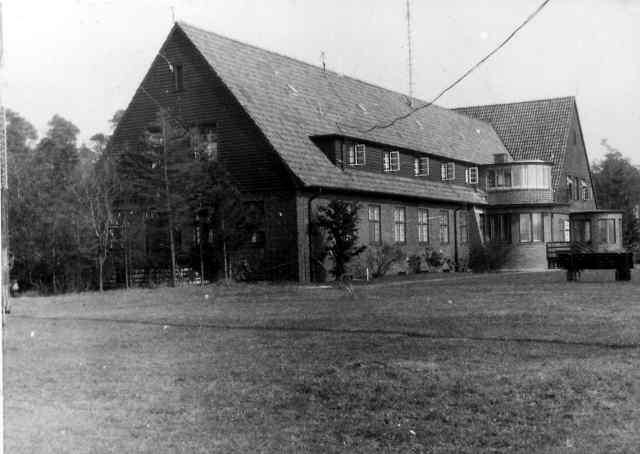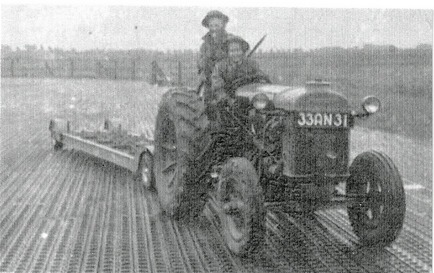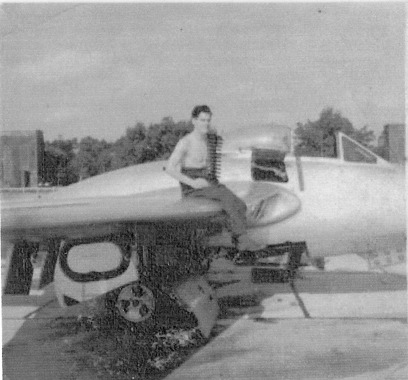
RAF Jever Control Tower, 1957
Courtesy SAC H Wilson RAF
1920s to 1935
The history of Jever as an airfield falls into three distinct periods; from the mid-twenties until 1935 as the property of a civilian flying club; from 1935 until 1945 as an operational Luftwaffe base and from 1951 until the present day as an R.A.F. Fighter Station as part of the N.A.T.O. defence.
During the 1920’s the employees of the Focke WulfAircraft Co., of Bremen decided to form a sports flying club, starting with a nucleus of World War I pilots. By 1926 they had built up a thriving club with seven light aeroplanes located on a small aerodrome at the edge of Upjever forest. However, within ten years this field was commandeered for more aggressive purposes and the Luftwaffe transformed it into a fighter base.
1935 to 1945
Work began early in 1935 clearing the forest and proceeded rapidly. The Station Headquarters was the first building to be completed and then the Hangars, Fire Station, M.T. Buildings, Sick Quarters and underground Petrol Installations followed in quick succession. Within the space of one year the Station was ready for its official opening which took place on 1st May 1936, when General Milch handed over to the first commandant, Hauptmann Malrich.
The first operational unit, a fighter Gruppe of three Staffeln, occupied Jever in June, 1937. Even at the time of the Munich Crisis in 1938 there was still only one fighter Gruppe here equipped with Me.109B’s.
In August 1937 the unit had only fifteen fighters instead of its establishment of thirty-nine and of those only five were serviceable.
At the beginning of September 1939, Jever was once more in the operational picture with the formation of the first Gruppe top be equipped with Me.109’s and Me.110’s, which in September 1939, were responsible for causing heavy casualties to a force of 22 Wellington aircraft carrying out a raid on naval vessels in the Schillig Roads and Wilhelmshaven.
This account is not entirely accurate. Chris Stone, who was ‘A’ Flight Commander on No. 93 Squadron at RAF Jever, was later the Station Commander of RAF Wattisham. He relates the full story from the History of RAF Wattisham as follows:
There is, however, a mistake I think in the last paragraph of page 5 where it references the station’s Me 109s and 110s attacking Wellingtons. The bombers were, in fact, fifteen Blenheims. There were five each from Nos 107 and 110 Squadrons based at RAF Wattisham, and five from No. 139 Squadron based at Wyton. The raid had the distinction of being the very first to be mounted against Germany in WWII, and was carried out at low level against German battleships anchored in the Schilling Roads on 4th September, 1939. The 5 aircraft from 139 Sqn failed to find the target and so returned with their bombs to Wyton. The 10 aircraft from Wattisham did find the ships, but the bombs that found their mark merely bounced off the heavy armour plating. The only German ship to be damaged was the cruiser Emden when one of the Blenheims, shot up during the attack, crashed into it. Just five aircraft returned safely to Wattisham.
From the beginning of 1940 to July, 1941 there were no tactical units at Jever. In July 1941 Jever became the Headquarters of the 2nd Fighter Division and the Fighter Command of the German Bight, with one squadron of Me.109’s and another two squadrons on the islands of Wangerooge and Borkum.
In 1942 the Headquarters of the 2nd Fighter Division moved to Stade near Hamburg, leaving Jever with a Fighter Gruppe of Me.109’s. This Gruppe took part in the attacks against the first American Bomber Forces to raid Germany in daylight.
A formation of Ju.52s, for duties in mine searching were added to the forces at Jever in 1945. Towards the end of the war the fighter formations left the aerodrome and were replaced by No.4 Night Fighter Wing equipped with Ju.188’s. Shortly before the surrender, all aircraft were flown to Leck, Schleswig-Holstein, to be destroyed; consequently when the Polish troops entered the station on 8th May 1945, there were no aircraft left on the airfield.
1945 to 1960
The Luftwaffe did not develop Jever airfield to any extent. After its occupation by the 7th Armoured Division in 1945 it was listed as an auxiliary landing ground with no concrete runways, no radio facilities, and no lighting. Its grass runway was 1,300 yards long, the total size of the field being 1,800 yards from east to west and 1,000 yards from north to south. In 1947 it was removed from the list of auxiliary landing grounds.
Between 1945 and 1951 the station was occupied successively by Polish and Canadian Army Units, the 11th Hussars, the Danish Army and by Jewish displaced persons.
In 1951 the Royal Air Force decided to develop Jever as a jet fighter base and so began what is perhaps the most important period of its history as an operational station.During 1951 a concrete runway, 6,000 ft by 150 ft was constructed, radio facilities, lighting and underground fuel storage tanks were added, accommodation was improved with the object of making Jever an important contribution to the North Atlantic Treaty Organisation Defence Scheme. Development of the airfield has continued since 1955, when it was nominated a N.A.T.O. main Fighter Base.
In March, 1951 No. 5352 Wing Detachment and a small nucleus of administrative officers arrived to start the work necessary to expand the station. On 11th February, 1952, the first British jet, a Vampire, touched down at Jever. In early March the first three squadrons arrived, Nos. 4, 93 and 112, all equipped with Vampires and Meteor trainers, which served them faithfully until superseded by Sabre IV’s in May, 1953. July of that year saw the departure of 112 Squadron from Jever to Bruggen, leaving only 4 and 93 until April, 1955, when No. 98 and No. 118 Hunter Squadrons moved in from Fassberg. In June 1955, No. 2 (F.R.) Squadron, equipped with Swifts moved in from Geilenkirchen.
The Mess itself was built for the German officers in 1938/39 at a cost which was high even for those days. It is said to have been lavishly furnished. The paintings in the Ante-Room are an indication of this, as they alone cost in the region of 8,500,000 reichmarks. They were painted in situ by a Professor Paul Scheurich, born in New York in 1885, pupil at the Berlin Academy of Arts and finally Professor at the State-Porcelaine-Manufactory in Maissen. He died during the war. The painting on the north wall shows events in connection with the history of the Jade Busan during the time of the Gross Kurfürst (the Great Elector – Frederich Willhelm, 1640-1686) by whom, it is understood, a harbour was built for the Brandenburg-Prussian Fleet. The painting on the east wall has no known significance but it depicts the eighteenth century and its title is believed to be “Rider and Escort on Foot.”
Alterations to the Mess made by the Royal Air Force consist of the addition of the dining-room and sleeping accommodation and the extension of the kitchens.
Courtesy of Jever Steam Laundry
Edward McKeirnan, No 4 Squadron, RAF Jever, BAFO 1952

The picture above shows the contributor driving a tractor, during an alarm fearing attack from the Russians.
Edward McKeirnan, No 4 Squadron, RAF Jever, BAFO 1952
The weapons (shown below) were 4×20 mm cannons and/or tank busting rockets. The pilots were also being tested for accuracy.
The alarm (shown above) was real. Although we did not get attacked others did. You will not find anything in UK papers as the government was terrified of upsetting Uncle Joe. At that time there was no wall or minefields between them and us. When it suited them the Ruskies would attack either the Yanks in the south or our army bases. They would drive forward about three miles then stop and scream bloody murder to the UN that they had been attacked. Then they would pull back about a mile and dig in. Six months later they would pull the same stunt in another area.
When I got back to the UK nobody would believe me. I was very happy to get home.
When I first arrived at Wunstorf we were told in the event of an attack we were to arm the aircraft send them off but they would fly back to our rear rearm then fly back to UK. We were to dig trenches against the T34 tanks. If you can get info from the government about this I will be gobsmacked. Sorry I made a mistake about the time. It was about six months later. Other than those times, I had the time of my life.

The above shows Edward during a more peaceful time practicing air firing tests on a de Havilland Vampire.
I must apologize for forgetting to tell you it was a Vampire squadron I was with for two and half years, No 4. I was of course an armourer. When old Joe started playing up, the three squadrons took turn about to do standby for a week at a time. We sat under the wings and played cards. That’s how I started smoking. We had the four x 20 mm Hispano cannons fully armed. Lying under the planes were eight rockets and two 500 pound bombs. When Joe cooled down we went back to normal flying. My boss, the armament sergeant, was just cruising waiting for demob, so as next in line I kept things going. After the first scares the RAF decided to make BAFO mobile. We had to prepare to move within two hours and head south. They asked every body to learn to drive. My father had sold ice cream out of cars and vans when I was 14 so I was driving in the back streets at that age.I reported to the MTO and told them I could drive so they tested me and said ok. Then by mistake instead of giving me a restricted to camp licence they gave me an unlimited one. I could drive vehicles even the MTO couldn’t drive. I was in heaven. I was now put in charge of the squadron transport, this was-huge German kaeble fuel bowsers, Coles crane, 1 x 15 hwt light truck, 1 x Land Rover,1 x Vanguard staff car,9 x three ton and 1 x five ton Thornycrofts.
I had to organise drivers for 1 truck. I drove the other truck. But first thing every morning I got the Land Rover to the Officers’ Mess. Then I took the light truck to the Sergeants’ Mess.I then collected the staff car and drove out to married qrts and handed it over to my CO. He was areal good bloke from Northallerton. Then he dropped me off at the MTO to pick up my truck. After work I pick them up and booked them in. As you can imagine, I was rather busy.
Well for a while every Saturday morning a couple of MIG 17s would circle above us, way up in the sky. Our Vampires couldn’t reach them. We would call up the Meteors from Gütersloh. We would then come towards the Ruskies slowly. When we got close, the reds would head for home. Some Sundays a stripped down Lincoln bomber would drop in to refuel heading back to the UK after being over the Rusky air zone. One of our sergeant pilots went back for OCU course. About a couple months later it dropped in to refuel and I took my bowser out and I was surprised to see him as one of the crew. I spoke to him but he turned his back to me. After they had gone I was told they were not allowed to talk to anyone. There was an occasion you may be able to check on a Meteor replacement piloted by a Flt Lt Driver crossed the zone by mistake they so they shot him down. They held him and his crashed plane for six months, before releasing him. By this time they had stripped the plane to pieces then dumped the bits in a swamp and gave our mob half an hour to get it out. Fun and games all round.
In reference to my comment regarding flights over the Russian zone with a Lincoln bomber in 1951, I have just come across the follow up action. The RAF made a new unit called the Special Duties Force led by squadron leader John Crapton, flying RB45 Tornados on loan from the US (all US insignia were erased and RAF roundels were put on the tails but no identity numbers). The Red Air national defence force relied on the Mig 15 (Fagot) which could not catch the RB45, so they built the Mig 21 (Fishbed) to do the job.
Edward McKeirnan, No 4 Squadron, RAF Jever, BAFO 1952
